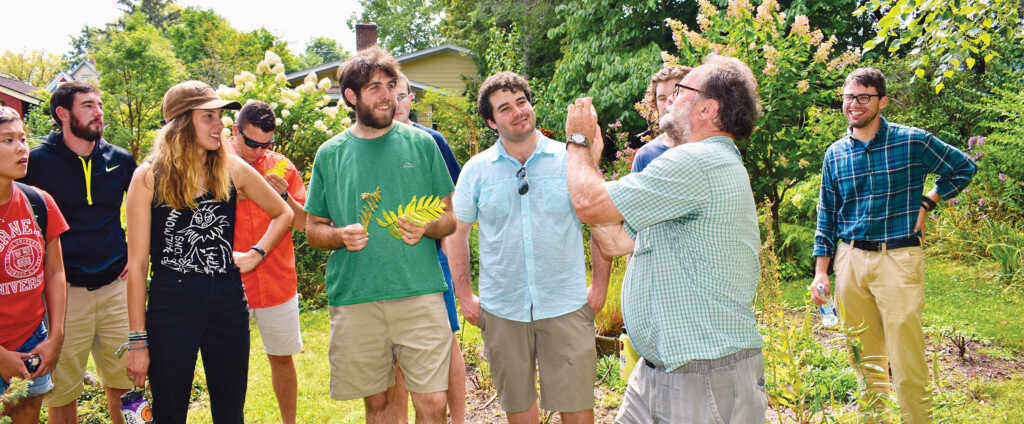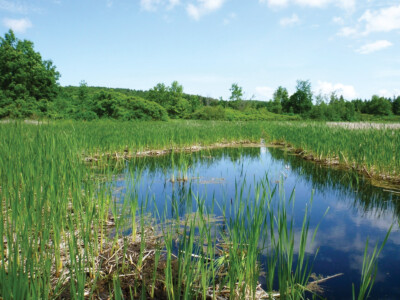Operation Restoration
By Claire B. Dunn
Two years after emerging as a focal point for the College’s future, the ESF Restoration Science Center (RSC) has established itself as a global force for efforts to improve the health and sustainability of ecosystems around the world.
“The United Nations General Assembly proclaimed 2021–2030 as the Decade on Ecosystem Restoration. On a global scale, nothing is more relevant to the future of the planet,” said Dr. Don Leopold, a Distinguished Teaching Professor who co-directs the center with Dr. John Farrell ’91, ’98, aquatic and fisheries science professor.
The name itself tells the story. “Restoration is a hopeful, intentional and meaningful way to reset our relationships with the environment. Science is the questions, tools and knowledge gained to learn, educate and adapt. Center is our community of diverse people with novel ideas, abilities and a shared commitment to a better future,” Farrell said.
Encompassing projects at levels from individual species to entire ecosystems, and across a range of terrestrial, wetland and aquatic environments, the RSC comprises more than two dozen ESF faculty members. Leopold ticks off the strengths of his colleagues across campus: restoration ecology, conservation science, traditional ecological knowledge, food systems, environmental science, engineering, landscape design and community engagement. He said they are on ”a transformational mission” together.
The RSC grew out of the ESF Discovery Challenge, which engaged the campus in setting a new course for the College’s future. The center is expected to have a sweeping impact across the eastern United States through Dr. William Powell’s work on restoring the American chestnut and American elm trees. In the Galapagos Islands, off the coast of Ecuador, ESF’s work focuses on restoring the famed giant tortoises and the ecosystems they inhabit.
Closer to home, the RSC touches the shore of Skaneateles Lake, where homeowners are implementing a “Lawn to Meadow” program developed by Samuel A. Quinn ’07, a research assistant with the RSC’s Conservation on Private Lands Initiative. (LINK)
And within reach of campus, the Syracuse Urban Food Forest Project benefits from ESF’s ties to Syracuse University as it examines ways
to create novel ecosystems by maximizing high quality food production on urban lands, many derelict. Leopold said the project illustrates the RSC’s unique approach: “Traditional ecological restoration often has a goal of restoring conditions to some ‘pristine’ reference condition.
But we’re trying to develop plant groupings that maximize ecological function and are adapted to today’s environment. We have traditional ecologists working with landscape architects and food scientists, and we’re taking into account the concerns of local communities and business economics.”
In the last year, RSC scientists have garnered more than $4 million in funding from state and federal agencies, philanthropic foundations and private donors to support restoration-related research at ESF. As the 2020-21 fiscal year drew to a close, the RSC worked with the ESF College Foundation, Inc., to secure support from the Central New York Community Foundation, the Emerson Foundation, and the Betsy and Jesse Fink Family Foundation. Extramural funding and philanthropy are vital to the center’s success, said Brandy Neveldine ’09, who joined ESF last year as a development officer.

Dr. Donald J. Leopold teaches students the fine points of plant science.
The Central New York Community Foundation provided a $36,070 grant to support land restoration programming in the Skaneateles Lake area. The work highlights the importance of Skaneateles Lake as the source of drinking water for the city of Syracuse and the need to educate private landowners along the lake about how to restore and manage their property to protect the water quality. The goal is to create demonstration sites for the public to visit and learn about restoration,
and provide hands-on training opportunities for ESF students. Doing fieldwork on the project this summer are Jessica Proctor, a new master’s student, and Ph.D. student Shumaila Bhatti.

Restored coastal wetland habitat in the St. Lawrence River area benefits northern pike and other wetland wildlife.
The Emerson Foundation provided $28,000, part of a broader grant to the Cayuga Lake Watershed Network, which is partnering with ESF. The funding supports ESF scientists in responding to harmful algal blooms (HABs) in Cayuga Lake. Researchers are trying to determine the source of nutrients that can encourage HAB growth. New microbial source-tracking technology applied at ESF in Dr. Hyatt Green’s lab using quantitative polymerase chain reaction analysis can determine if bacteria in water originated from humans, domestic animals, wildlife or other sources. Pinpointing the source provides a base for sound decision-making in mitigation and restoration efforts. Fieldwork is led by Dr. Michael Schummer ’98, who is assisted this summer by graduate student Anthony Dolce. The project will serve as a model for sustaining water quality throughout the Finger Lakes.
The Betsy and Jesse Fink Family Foundation is supporting a new, full-time research ecologist who will join the RSC team later this year. This scientist will develop programs that focus on native plant and pollinator restoration across varied ecosystems, a challenge that touches much of RSC’s work. The researcher will also work with other foundation collaborators, including Biodiversity Works, on Martha’s Vineyard, where they are working to engage private landowners in restoring wildlife corridors.
The collaboration complements the RSC Conservation on Private Lands Initiative, which focuses on helping private landowners achieve the delicate balance between biodiversity conservation and the practical need for property to provide a source of income. The students in the program learn to manage property from a conservation biology perspective. Much of the work is done in partnership with the Fuller Center for Productive Landscapes, which provided a gift four years ago to establish the Private Lands Initiative.
“We are looking at how to balance the property as a whole,” Quinn said. “How can the landowner still use it for productive purposes and simultaneously, be the best possible steward of their land’s biodiversity?”
The RSC has developed a network with 23 new partnerships that are leading to significant opportunities for ESF faculty and students to connect directly with practitioners in the field. Included among those collaborators are land trusts, businesses, governmental agencies, and civic and conservation groups.
“So much is happening and more is possible. We are collaborating to help regain lost ecological potential by restoring degraded sites with science-based methodology,” Farrell said. “Restoration also involves the work of changing our relationships with land and water. We can – literally and figuratively – build a brighter and healthier future. Through the process, biodiverse and resilient habitats are expected to develop and thrive, providing ecosystem services that grow biocultural value and lead to positive nurturing feedbacks by people. It’s exciting to be a part of this transformation and ESF is the catalyst that makes it happen.”
Claire B. Dunn is a writer and director emeritus of the ESF Office of Communications and Marketing.


